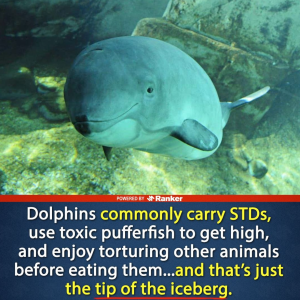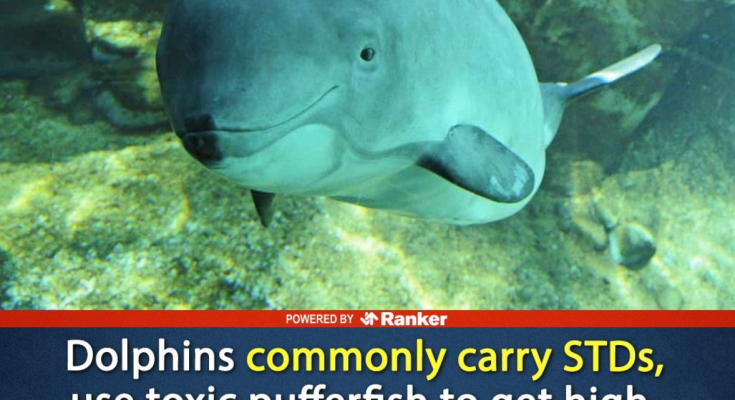1. They Can Be Shockingly Violent
Dolphins might be marketed as gentle ocean ambassadors, but in the wild, they can be startlingly aggressive — not just toward prey, but toward each other. Male dolphins, especially bottlenose dolphins, are known to form alliances and gang up to attack rivals. These fights can result in serious injuries, and the violence isn’t limited to territorial disputes — sometimes it’s purely for dominance displays.
2. Infanticide Happens
One of the most disturbing behaviors observed in dolphins is the intentional killing of calves. Some male dolphins will attack and kill newborns — sometimes of their own species, sometimes not. The reasoning is grim: by eliminating a calf, the mother becomes fertile again sooner, giving the male a chance to mate. This behavior, while shocking, is not uncommon in the animal kingdom, but it’s especially unsettling in an animal often portrayed as loving and nurturing.
3. They Torment Other Animals
Dolphins don’t just hunt to eat — sometimes they seem to harm other animals for sport. Observers have recorded dolphins tossing fish, squid, and even small sharks into the air, letting them fall, and repeating the process for extended periods without eating them. Scientists debate whether this is “play” behavior or practice for hunting, but in some cases, it appears to be pure harassment.
4. They Can Be Bullies to Porpoises
It’s not just smaller prey that’s at risk. Dolphins have been documented killing porpoises — smaller, harmless relatives — for no apparent benefit. Unlike predation, these killings don’t result in food consumption. Instead, they involve violent attacks with repeated ramming, leading some researchers to suspect it’s a form of aggression release or a twisted way of reinforcing dominance.
5. Their Mating Tactics Can Be Disturbingly Coercive
In dolphin society, courtship can be far from romantic. Males often work together to isolate a female, chasing her for hours or even days, blocking her escape, and mating repeatedly. This forced copulation, while common in the animal world, runs counter to the friendly, playful image many have of dolphins.
6. They Use Deception
Dolphins are smart — and they know how to use that intelligence for manipulation. In captivity, dolphins have been seen hiding food under sand or behind objects to keep it away from tank mates until they want it. In the wild, they’ve been known to use misleading calls to trick rivals or competitors, giving themselves an advantage in hunting or mating situations.
7. They Sometimes Get High on Pufferfish Toxins
A strange but documented phenomenon: young dolphins have been filmed playing with pufferfish, gently mouthing them and passing them around like a ball. Pufferfish release a neurotoxin as a defense, which in small doses can produce a trance-like state. Some researchers suspect these dolphins are intentionally exposing themselves to the toxin for a “high,” showing they may indulge in recreational drug use — animal-style.
8. They’ve Been Known to Attack Humans
While wild dolphin attacks on humans are rare, they do happen — and they can be serious. Some incidents involve territorial defense, while others occur when dolphins mistake humans for rivals or simply get aggressive during interactions. In captivity, incidents are more frequent, with dolphins biting, ramming, or dragging trainers underwater when stressed or provoked.
9. They Can Abandon Sick or Injured Pod Members
We love stories about dolphins helping wounded pod mates, but the truth is, not every dolphin gets that treatment. In tough situations, especially when food is scarce or predators are nearby, a sick or injured dolphin might be left behind. In the ocean, survival sometimes trumps sentiment.
10. They Have Complex — and Sometimes Cutthroat — Social Hierarchies
Dolphins live in fluid social groups where alliances shift and power struggles are constant. Males, in particular, form coalitions to increase their social standing, sometimes betraying former allies. These politics can determine access to mates, food, and even protection, but they also lead to intense rivalry and backstabbing — in the most literal sense.
11. They’re Opportunistic Predators
Although they often target fish and squid, dolphins won’t hesitate to eat other marine animals if the opportunity arises. They’ve been documented preying on seabirds, small whales, and even young members of their own species. Their hunting tactics are ruthless and highly effective, which is part of why they’re such successful marine predators.
Dolphins aren’t villains — they’re wild animals. The behaviors we see as “dark” are part of their survival strategy, honed over millions of years. The problem is less about the dolphins themselves and more about the unrealistic image humans have built around them. They’re not smiling sea angels — they’re apex predators with brains big enough to plan, deceive, and dominate. And in their world, that’s exactly what it takes to survive.


